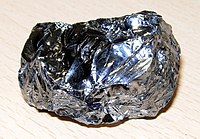
Photo from wikipedia
Abstract The technological exploitation of palladium or palladium nanoparticles (PdNPs) is increasing, and their wider usage relates to an unwanted release of pollutants into the environment, raising public health concerns… Click to show full abstract
Abstract The technological exploitation of palladium or palladium nanoparticles (PdNPs) is increasing, and their wider usage relates to an unwanted release of pollutants into the environment, raising public health concerns about the infiltration of palladium into the consumption chain. This study focuses on the effect of spherical gold-cored PdNPs of 50 ± 10 nm diameter stabilized by sodium citrate on the interaction between an oilseed rape (Brassica napus) and the fungal pathogen Plenodomus lingam. Pretreatment of B. napus cotyledons with PdNPs suspension 24 h before but not 24 h after inoculation with P. lingam resulted in a decrease in the extent of disease symptoms; however, this effect was caused by Pd2+ ions (35 mg l–1 or 70 mg l–1). Tests to determine any direct antifungal activity on P. lingam in vitro demonstrated that the residual Pd2+ ions present in the PdNP suspension were responsible for the antifungal activity and that PdNPs themselves do not contribute to this effect. Brassica napus plants did not show any symptoms of palladium toxicity in any form. PdNPs/Pd2+ slightly increased the chlorophyll content and the transcription of pathogenesis-related gene 1 (PR1), indicating the activation of the plant defence system. We conclude that the only toxic effect of the PdNP suspension was on P. lingam via ions and that PdNPs/Pd2+ did not have any deleterious effect on the B. napus plants.
Journal Title: AoB Plants
Year Published: 2023
Link to full text (if available)
Share on Social Media: Sign Up to like & get
recommendations!